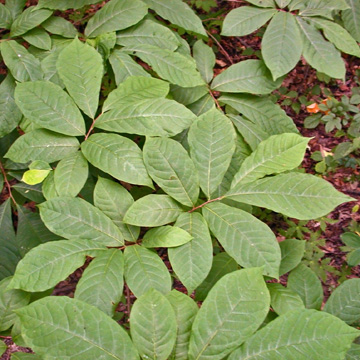

Asimina triloba - (image 1 of 5)
Taxonomy
Family: Annonaceae
Habitat
Rich, mesic or damp woods, often on alluvial soils.
Associates
Acer saccharum, Carpinus caroliniana, Fraxinus americana, Lindera benzoin, Quercus rubra, Tilia americana, Ulmus rubra.
Distribution
Western NY and southern Ontario west to southern MI and eastern NE, south to FL and TX.
Morphology
Shrub or small tree to 10 m. Leaves large, entire, oblong-obovate, short-acuminate. Flowers perfect, dark purple, 3-4 cm wide; petals in 2 whorls of 3; sepals 3, soon deciduous. Fruit few or solitary, to 15 cm long, yellow-brown, darkening with age, containing many large, shiny, dark brown seeds surrounded by a creamy aromatic pulp.
Notes
Flowers April or May
Wetland Indicator: Facultative
This tree is interesting in that is a far north-ranging member of a mostly tropical family. The Anonaceae is also known as the Custard-apple family, which includes the custard-apple, sugar-apple, and my personal favorite, the cherimoya (Annona cherimola). Much attention has been paid to the pawpaw as a potential commercial crop. Unfortunately the seeds occupy the majority of the fruit and the pulp is aromatic but somewhat bitter; perhaps selections have been made for fruit lacking the bitter properties. The tree is useful for the tropical look of the foliage and the fruit is at least novel for its size. It is hardy to USDA Climate Zone 5.
References
Dirr, Michael A.
1998. Manual of Woody Landscape Plants: Their Identification, Ornamental
Characteristics, Culture, Propagation and Uses.
5th ed. Champaign, Illiois: Stipes Publishing L.L.C.
Gleason, Henry A. and A. Cronquist. 1991. Manual of Vascular Plants of Northeastern United States and Adjacent Canada. Second Ed.
The New York Botanical Garden. Bronx, NY
Swink, F. and G. Wilhelm. 1994. Plants of the Chicago Region.
Indiana Academy of Science. The Morton Arboretum. Lisle, Illinois.
|
© Michael Hough 2004 |